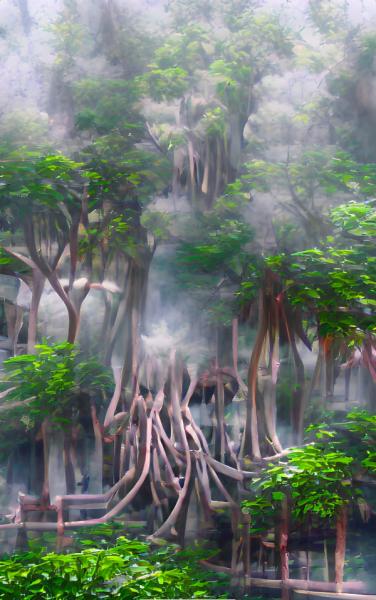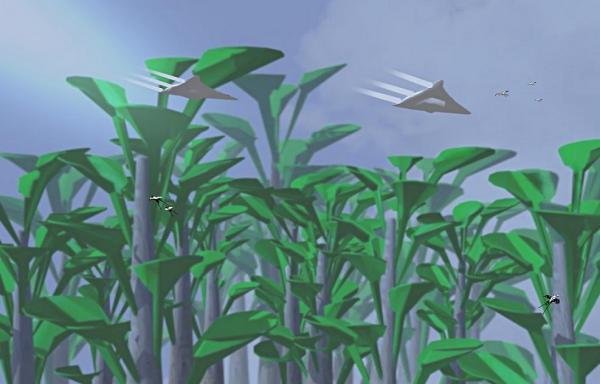BY LETTER
Akilaspek Trees
Technology > Technology Type or Material > Gengineering
Technology > Technology Levels > High Tech / Hitech
Technology > Application > Infrastructure
Technology > Technology Type or Material > Nanotech
Technology > Technology Type or Material > Organic/Biotech
Technology > Technology Levels > High Tech / Hitech
Technology > Application > Infrastructure
Technology > Technology Type or Material > Nanotech
Technology > Technology Type or Material > Organic/Biotech
Giant planetbound trees used for food production and habitation | |
 Image from JohnnyYesterday | |
| Many Akilaspek trees have multiple layers of canopy that gather water or water vapour from the atmosphere | |
Akilaspek are a clade of neogenetic arboreal organisms. Structurally, they resemble Terran banyan trees, starting as a single-trunked organism, which continues to propagate itself outwards by supporting its expanding canopy with adventitious prop roots (epi-trunks). Theoretically, akilaspek can continue to grow outwards indefinitely. The largest yet, The Great Akilaspek on the suprastellar habitat Irethrocomi, covers an area of 1,234,839,507 square kilometers, as of Mendel 28 10,600.
Some akilaspek sub-clades can grow to a height of approximately five kilometers in a one gee Gaian environment. Their limiting factor is the height of the highest rainclouds. They cannot transport water more than approximately one hundred meters above their highest reservoirs via passive transpiration. Instead of taking up water through their roots like Terran trees, akilaspek gather water with their specialized leaves. Akilaspek leaves are circular, hydrophobic (see lotus effect) and slightly inward sloping. Leaf-stems project to the middle of the top surface of the leaf, and have a single duct which accepts the funneled rain into the tree. A fractal aqueduct network exists between the leaves and roots. Water is stored in reservoir cavities throughout the limbs, primary and epi-trunks.
In tropical environments, akilaspek do not utilize most of the water they collect. It is released in various aesthetic ways, such as babbling streams which meander down channels in the top sides of branches, waterfalls, misting pores, which utilize the force of gravity to atomize water, springs and fountains. Depressions in branches form small lakes, supporting diverse life
Akilaspek fix their own nitrogen from the atmosphere. Other nutrients are gathered from the soil by the roots, and are transported by internally ciliated tubules--the ciliotubule system--through the plant. Roosting bionts leave nutrient-rich waste in the canopy, and this often finds its way into the tree. Some animal, etc. clades instinctually excrete on the leaves. The leaves are washed clean, the excreta carried inside the tree, with the next rainfall.
Most akilaspek produce multiple types of edible structures. They are not technically fruit, because they do not contain seeds, but are often called fruit by non-biologists anyway.
The baseline akilaspek genome was designed to be minimalist and efficient, having only 21,542 genes. Some akilaspek genomes measure into several hundreds of millions of genes. The vast genomes code for specialized features. Examples include the Neelembee tree, thousands of varieties of edible structures, and aesthetic variations.
Akilaspek may reproduce either sexually or asexually. Produced seeds are dispersed by wind or water. Vegetative growth is the primary reproductive strategy in some sub-clades.
Akilaspek are divided into two primary sub-clades based upon the composition of their cell walls and other support structures. Sub-clade Alpha has cell walls composed of a composite of protein-silk and lignutopin. Sub-clade Beta cell walls are based on various allotropes of carbon--graphite fiber composites, and diamondoid-nanotube tension-compression composite.
Some akilaspek serve as habitats for sophonts, and are gengineered accordingly. Cavities within branches and trunks provide usable space. Illumination is provided by bioluminescent protrusions, surfaces, and in daylight hours by grown optical fiber lightpipes. Outside of biopolities, artificial lighting is more widespread.
Some akilaspek become elaborate woodcarvings. What would kill a Terran tree, by damaging its phloem and xylem transport tissues, doesn't severely harm akilaspek. The ciliotubule, and water transport systems are predominately located deep within the wood of the tree.
Akilaspek carving is ritualized in some religious traditions. In some Shaktism (Shakti Hinduism) traditions, the body of the tree is associated with the goddess Shakti, and is decorated with images of creation and representations of life in all its forms.
Some akilaspek sub-clades are designed to grow in aquatic environments. All sub-clades can propagate into water by vegetative growth, but only those which grow from anchor seeds can germinate in water more than a few meters in depth.
 Image from Steve Bowers | |
| This variant of Akilaspek tree collects rainwater using large circular leaves. In addition, some varieties have Semicircular platforms which grow from larger branches and trunks. They are utilized for landing aerospace craft, as recreation and sunbathing areas, etc. | |
Related Articles
Appears in Topics
Development Notes
Text by Johnny Yesterday
Initially published on 29 December 2005.
Image by JonnyYesterday, using Nightcafe art software, added 2022, plus minor text adjustments
Initially published on 29 December 2005.
Image by JonnyYesterday, using Nightcafe art software, added 2022, plus minor text adjustments






